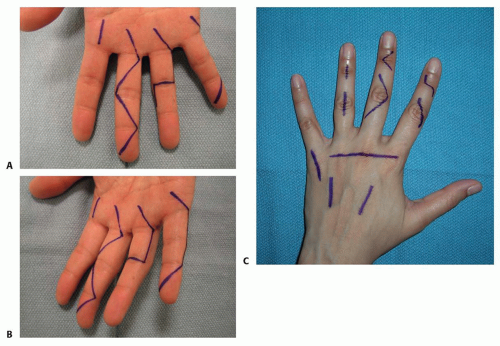Compartments |
Origin |
Insertion |
Innervation |
Thenar |
Abductor pollicis brevis |
Trapezium/scaphoid |
Radial base of thumb P1 |
Median (recurrent motor branch) |
Flexor pollicis brevis |
Trapezium |
Base of thumb P1 |
Median (recurrent motor branch) |
Opponens pollicis |
Trapezium |
Radial base of thumb P1 |
Median (recurrent motor branch) |
Adductor |
Adductor pollicis |
Capitate/third metacarpal |
Ulnar base of thumb P1 |
Ulnar |
Hypothenar |
Abductor digiti minimi |
Pisiform |
Ulnar base of small P1 |
Ulnar |
Flexor digiti minimi brevis |
Hook of hamate |
Base of small P1 |
Ulnar |
Opponens digiti minimi |
Hook of hamate |
Ulnar base of small P1 |
Ulnar |
Interosseous |
Dorsal interossei (4) |
#2, 3, 4, 5 metacarpals |
Radial or ulnar base of P1 |
Ulnar |
Volar interossei (3) |
#2, 4, 5 metacarpals |
Radial or ulnar base of P1 |
Ulnar |
Carpal Tunnel |
Flexor digitorum profundus and superficialis tendons, lumbricals, flexor pollicus longus tendon, median nerve |
Hook of hamate |
Scaphoid tubercle |
|
Superficial Volar Forearm |
Pronator teres |
Medial epicondyle |
Mid-third of radius |
Median |
Flexor carpi radialis |
Medial epicondyle |
Base of #2 MC |
Median |
Palmaris longus |
Medial epicondyle |
Palmar fascia of hand |
Median |
Flexor carpi ulnaris |
Medial epicondyle |
Pisiform/base of #5 MC |
Median |
Flexor digitorum superficialis |
Medial epicondyle |
Base of #2, 3, 4, 5 P2 |
Median |
Deep Volar Forearm |
Flexor digitorum profundus |
Ulna/interosseous membrane |
Base of #2, 3, 4, 5 P3 |
#2, 3 – Median (ant. interosseous branch)
#4, 5 – Ulnar nerve |
Flexor pollicis longus |
Distal third of radius |
Base of thumb P2 |
Median (ant. interosseous branch) |
Pronator quadratus |
Distal third of ulna |
Distal third of radius |
Median (ant. interosseous branch) |
Dorsal Forearm |
Abductor pollicis longus |
Mid-third dorsal radius |
Radial base of thumb MC |
Radial (post. interosseous branch) |
Extensor pollicis brevis |
Mid-third dorsal radius |
Dorsal base of thumb P1 |
Radial (post. interosseous branch) |
Extensor pollicis longus |
Dorsal ulna |
Dorsal base of thumb P2 |
Radial (post. interosseous branch) |
Extensor digitorum communis |
Lateral epicondyle |
Dorsal base of #2, 3, 4, 5 P3 |
Radial (post. interosseous branch) |
Extensor indicis proprius |
Dorsal ulna |
Dorsal base of #2 P3 |
Radial (post. interosseous branch) |
Extensor digiti quinti |
Lateral epicondyle |
Dorsal base of #5 P3 |
Radial (post. interosseous branch) |
Extensor carpi ulnaris |
Lateral epicondyle |
Dorsal base of #5 MC |
Radial (post. interosseous branch) |
Supinator |
Lateral epicondyle |
Proximal third of radius |
Radial (post. interosseous branch) |
Mobile Wad |
Brachioradialis |
Lat. condyle humerus |
Distal radius styloid |
Radial |
Extensor carpi radialis longus |
Lat. condyle humerus |
Dorsal base of #2 MC |
Radial |
Extensor carpi radialis brevis |
Lat. condyle humerus |
Dorsal base of #3 MC |
Radial (post. interosseous branch) |
P1, proximal phalanx; P2, middle phalanx; P3, distal phalanx; ant., anterior; MC, metacarpal; post., posterior; lat., lateral. |











